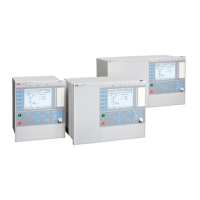13.6.4 Four step residual overcurrent protection EF4PTOC
Prepare the IED for verification of settings as outlined in section "Overview" and
section "Preparing for test" in this chapter.
13.6.4.1
Four step directional overcurrent protection
1. Connect the test set for single current injection to the appropriate IED terminals.
Connect the injection current to terminals L1 and neutral, or to terminals N
and neutral.
2. Set the injected polarizing voltage slightly larger than the set minimum
polarizing voltage (default 5% of Ur) and set the injection current to lag the
voltage by an angle equal to the set reference characteristic angle (AngleRCA)
if the forward directional function is selected.
If reverse directional function is selected, set the injection current to lag the
polarizing voltage by an angle equal to RCA+ 180°.
3. Increase the injected current and note the value at which the studied step of
the function operates.
4. Decrease the current slowly and note the reset value.
5. If the test has been performed by injection of current in phase L1, repeat the
test when injecting current into terminals L2 and L3 with a polarizing voltage
connected to terminals L2 respectively L3.
6. Block lower set steps when testing higher set steps according to the
instructions that follow.
7. Connect a trip output contact to a timer.
8. Set the injected current to 200% of the operate level of the tested step, switch
on the current and check the time delay.
For inverse time curves, check the operate time at a current equal to 110% of
the operate current for txMin.
9. Check that all trip and start contacts operate according to the configuration
(signal matrixes)
10. Reverse the direction of the injected current and check that the step does not
operate.
11. Check that the protection does not operate when the polarizing voltage is zero.
12. Repeat the above described tests for the higher set steps.
13. Finally, check that start and trip information is stored in the event menu.
13.6.4.2 Four step non-directional overcurrent protection
1. Do as described in
"Four step directional overcurrent protection", but without
applying any polarizing voltage.
Section 13 1MRK 504 088-UEN C
Verifying settings by secondary injection
138
Installation and commissioning manual

